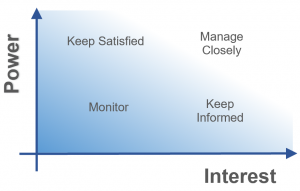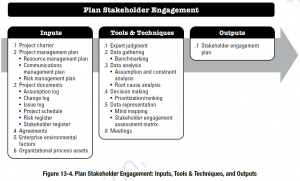
All projects have stakeholders.
Like any area of life, no projects exist inside of a bubble. Although some come close, every project must have a project sponsor (as a minimum) who created the project and expects some sort of deliverables. But most projects have so many stakeholders that they must maintain a list in order to manage them all properly.
In project management, stakeholders are anyone who is affected by the project. Stakeholders are the lifeblood of the project because they define whether the project was a success or failure.
Hence, stakeholder management is one of the most important components of project management.
That’s why the Project Management Body of Knowledge (PMBOK) contains stakeholder management as a separate knowledge area, the tenth out of ten. It contains four processes:
- Identify Stakeholders
- Plan Stakeholder Engagement
- Manage Stakeholder Engagement
- Monitor Stakeholder Engagement
The PRINCE2 project management method does not have a methodology specific to stakeholders except for the communications plan, under the Organization theme, which describes the means and frequency of communications to stakeholders both internal and external to the project.
The International Project Management Association’s Individual Competence Baseline (ICB) identifies Stakeholders as 1 out of 29 competence elements for project managers. It contains five key performance indicators:
- Identify stakeholders and analyse their interests and influence
- Develop and maintain a stakeholder strategy and communication plan
- Engage with the executive, sponsors and higher management to gain commitment and to manage interests and expectations
- Engage with users, partners, suppliers and other stakeholders to gain their cooperation and commitment
- Organize and maintain networks and alliances
Clearly, stakeholder management is a central component to the practice of project management, and is well addressed in the written methodologies. The first primary step is to identify the project stakeholders.
How to Identify Stakeholders
 Before you can manage any stakeholders, you have to identify them, and this is where the rubber meets the road. It is surprisingly easy to ignore a minor stakeholder who then causes changes to the project greater than their stake in it because they were not adequately consulted.
Before you can manage any stakeholders, you have to identify them, and this is where the rubber meets the road. It is surprisingly easy to ignore a minor stakeholder who then causes changes to the project greater than their stake in it because they were not adequately consulted.
Stakeholders can be identified from a checklist, but ideally each portion of the project is analyzed to determine who is affected.
- Upwards stakeholders are those that are involved in the ownership and funding of the project. It includes the project sponsor, executives from the parent organization, lenders, creditors, and shareholders. These stakeholders wish to see the project succeed so that they can realize a return on their investment, but they have varying communication needs which the project manager must be aware of.
- Downwards stakeholders are those that carry out the project work. It includes contractors, suppliers, and the project team. Downwards stakeholders wish to be fairly compensated for their work, and to leave the project with a slightly better chance at being chosen for the next one (or job). This is accomplished via career development, references, experience, and so forth.
- Outwards stakeholders are those that have a stake in the project, for example adjacent landowners, government regulatory agencies, unions and trade organizations, and so forth. They all have different needs and wants. The project manager must determine what their needs are and how they will influence the project. Often included in this category are the customer and end users, and even the general public if they are considered a stakeholder.
- Sideways stakeholders are those that compete with the project for limited resources. This includes other projects, technical/department managers, and so forth. They are not necessarily opposed to the project, rather they have needs that need to be met, for example the return of a resource back to the technical department in a certain condition.
The stakeholders are identified and entered into a stakeholder register.
How to Perform Stakeholder Analysis
 Stakeholder analysis centers around two variables:
Stakeholder analysis centers around two variables:
- Power is the stakeholder’s ability to change or stop the project
- Interest is the amount that the stakeholder is affected by the project.
These two variables are plotted on a Power-Interest Matrix, which contains the Interest on the x-axis and the Power on the y-axis.
Depending on where on the chart the stakeholder lies, the management of the stakeholder can be defined.
- Stakeholders with low power and low interest are minor stakeholders. They should be monitored.
- Stakeholders with high power and low interest have a disproportionately high amount of influence on the project. They must be kept satisfied.
- Stakeholders with low power and high interest are not in a position to influence the project, but can influence others. They must be kept informed.
- Stakeholders with high power and high interest are major stakeholders. They must be actively managed.
Stakeholders are analyzed according to the underlying factors the drive them:
- Financial interests
- Moral and ethical values
- Religious beliefs
- Political opinions
- Business interests
- Demographics
- Environmental stewardship
- Value of ownership
- Communication preferences
These factors are analyzed to determine what the stakeholder really wants and how they are expected to attempt to get there.
A stakeholder engagement plan defines how the project will engage with the stakeholders to achieve their buy-in. Of course, it should be scaled up or down to the size of the project, but I would argue that even the smallest projects have stakeholders who present a significant risk to project success if you can’t articulate their needs in writing.
How to Engage Stakeholders
The PMBOK specifies the use of a stakeholder engagement assessment matrix, which tracks each stakeholder as they are move towards buy-in. The stakeholder engagement assessment matrix shows where the stakeholder currently is (C) versus their desired location (D).
The most difficult stakeholders, the ones which take the most of the project managers time, are those that have to move from “Resistant” to “Neutral.” This is a common occurrence. They usually require a strong engagement plan and good execution of the plan.
How to Perform Stakeholder Control
Project control is the actions which are undertaken by the project management team to keep the project on time and budget. But it is not limited to time and budget. Stakeholder control is a subset of project control and refers to those actions that ensure the stakeholder engagement plan is being carried out.
At the designated project control points, when earned value analysis is performed and progress reporting occurs, stakeholder control involves the following actions:
- Ensure the tasks in the stakeholder engagement plan have been completed.
- Check the stakeholder responses within the period to see if they have achieved buy-in, that is, if the stakeholder engagement has been a success. Update the stakeholder engagement assessment matrix if necessary.
- Re-analyze each stakeholder according to the analysis in the stakeholder engagement plan, to see if their needs have changed. This is a common occurrence and should not be overlooked. Stakeholder’s needs frequently change or get tweeked based on project activities, and insensitivity to those changes can be very detrimental. If any stakeholder analysis has changed, the stakeholder engagement plan will need to be updated.
Hopefully that gives you a firm foundation in managing project stakeholders. Most importantly, always err on the side of more communication, because I don’t think there was ever a project stakeholder who said they wanted to be consulted less. Good luck and let me know in the comments what your experience with stakeholders is.








